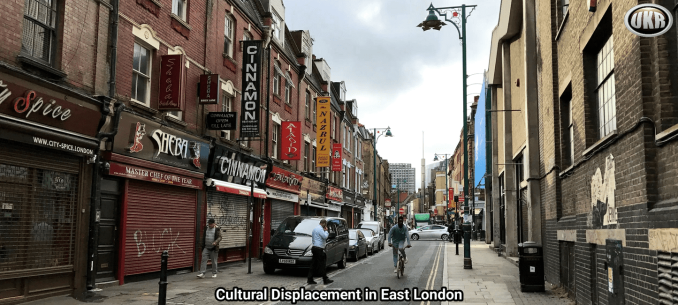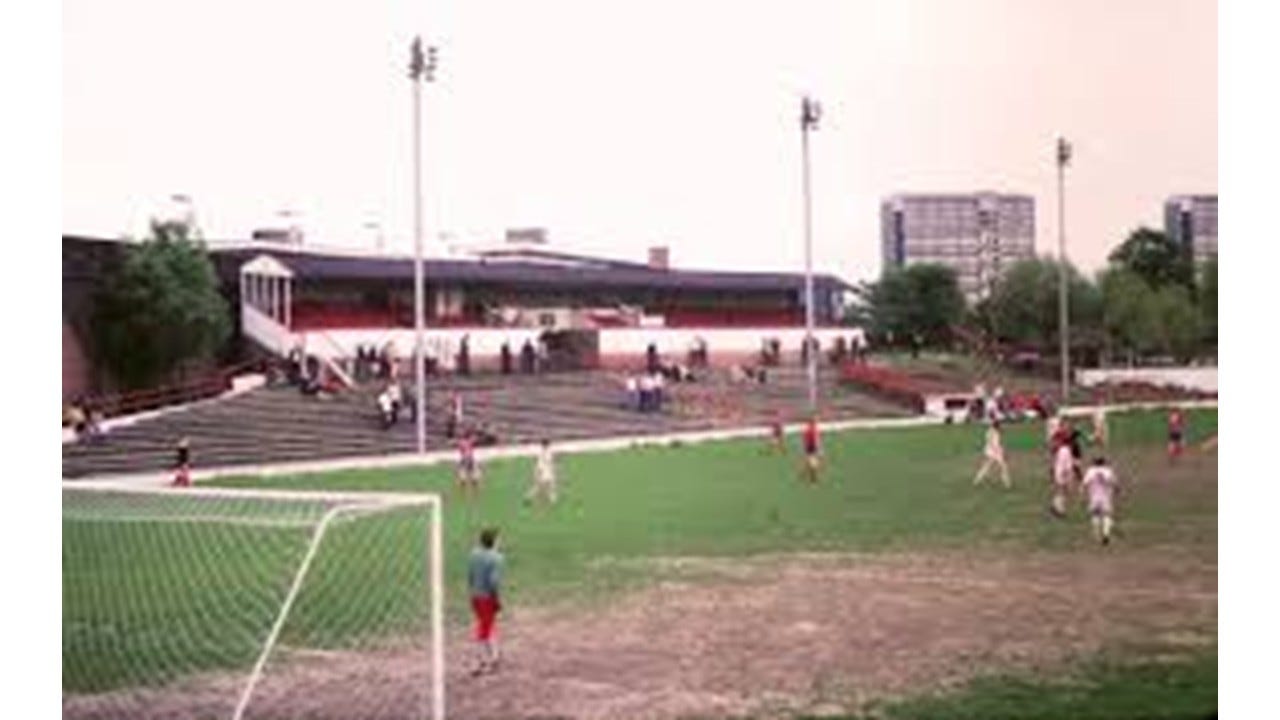
Cultural displacement in East London
NIALL MCCRAE
‘I’m from nowhere’ said a white British girl. This was on a Channel 4 documentary by Trevor Phillips, ‘Things We Won’t Say About Race (That Are True)’, and it illustrated Phillips’ theme about integration and belonging.[1]. The remark was regarded as the impact of multiculturalism and undermining of British identity. But in a way perhaps not intended, the girl spoke truth. East London, like many urban habitats in England, is now an undifferentiated, Asian-dominated domain of takeaway kebab shops, late-night grocers, mosques and overdeveloped housing. It is everywhere and nowhere.
The more people, the fewer amenities. This phenomenon may seem counter-intuitive: surely a booming population in our cities would generate a greater market for goods and services? But that depends on the commodity. Overall, there will be more consumption, but local community life is not necessarily improved, particularly if the influx is mostly from foreign countries and cultures. Churches, pubs, amateur dramatic societies, neighbourhood watch – all are disappearing fastest where white Britons are demographically replaced.
Demonstrating the decline of suburban life in London is the loss of local football clubs. The Isthmian League, comprising clubs from the London area, is a level below the national leagues on the football pyramid. Its premier division is equal to that of the Southern and Northern Leagues. I know it well, having supported Carshalton Athletic when I lived on the suburban fringe. Today, most of the competing clubs are from further out in the Home Counties, as far as the Sussex and Kent coast.
Many of the suburban London teams have gone forever. The fall has been steepest in the east of London. Leytonstone merged with Ilford in 1979. Both clubs had been supported well in the past. Back in 1948, a crowd of seventeen thousand packed into Ilford’s Lynn Road ground to watch India versus France in the London Olympics.
The combine played at Leytonstone’s Granleigh Road, a ground with a grandstand backing on to the raised platform of Leytonstone High Road railway station (shown below in the 1970s). Ten years later Leytonstone-Ilford moved a few miles north to Green Pond Lane, absorbing the famous Walthamstow Avenue. Of many FA Cup exploits, most celebrated was a match against Manchester United in 1953, when Walthamstow Avenue had the audacity to draw 1-1 at Old Trafford (losing the replay 2-5 at Highbury).
The club become Redbridge Forest, but it failed to secure a ground in Redbridge, and in 1992 the complex of former clubs moved out to Dagenham, still playing today as Dagenham & Redbridge at Victoria Road. Walthamstow lost both its football ground and its greyhound stadium to ‘progress’.

Romford, a club that aimed for Football League entry, was forced to leave its commodious Brooklands ground, which also had a speedway, in 1977. The renewed Romford shares a ground with Barking, another club that folded before being revived. The East End, previously a nest of footballing talent that produced the likes of Bobby Moore, David Beckham and Frank Lampard (senior and junior), has become a desert of local football clubs.
Amateur teams still play on Sunday mornings at Hackney Marshes. The Bengali community in Tower Hamlets has its own keenly contested league. But youngsters of all ethnicities are more interested in their mobile phones than playing or watching football in their area. Only the big clubs prosper, and few of their players are from London boroughs. More than half of major London clubs’ players may be black, but increasingly they are brought from abroad, rather than kids from Grange Hill.
West Ham United plays to huge crowds in the former Olympic stadium in Stratford, and Orient has its loyal support, but there is little local identity in the districts of east London. Few residents have been there for more than one or two generations. It’s rootless and atomised. The BBC series Eastenders is now a figment of imagination, unless the fictitious Walford were transported ten miles out, into Essex.
In my collection of Isthmian League football programmes is a fitting advertisement in a Wembley FC programme from 1979; a company providing an air cargo service asks the supporter in bold letters: ‘emigrating?’ If any progressive or leftist tells you that demographic replacement is a far-right conspiracy theory, simply ask them to explain what has happened to the Cockney populace of the East End.
Note
[1] I am grateful to Slobodan Antonijevic, who found this elusive quote that I had remembered from the recent past but couldn’t find online. The Channel 4 film is worth watching. Thanks also to Roger Watson for finding a similar quote, in a report that included an interview with Trevor Phillips.
This article (Cultural displacement in East London ) was created and published by Niall McCrae and is republished here under “Fair Use”

••••
The Liberty Beacon Project is now expanding at a near exponential rate, and for this we are grateful and excited! But we must also be practical. For 7 years we have not asked for any donations, and have built this project with our own funds as we grew. We are now experiencing ever increasing growing pains due to the large number of websites and projects we represent. So we have just installed donation buttons on our websites and ask that you consider this when you visit them. Nothing is too small. We thank you for all your support and your considerations … (TLB)
••••
Comment Policy: As a privately owned web site, we reserve the right to remove comments that contain spam, advertising, vulgarity, threats of violence, racism, or personal/abusive attacks on other users. This also applies to trolling, the use of more than one alias, or just intentional mischief. Enforcement of this policy is at the discretion of this websites administrators. Repeat offenders may be blocked or permanently banned without prior warning.
••••
Disclaimer: TLB websites contain copyrighted material the use of which has not always been specifically authorized by the copyright owner. We are making such material available to our readers under the provisions of “fair use” in an effort to advance a better understanding of political, health, economic and social issues. The material on this site is distributed without profit to those who have expressed a prior interest in receiving it for research and educational purposes. If you wish to use copyrighted material for purposes other than “fair use” you must request permission from the copyright owner.
••••
Disclaimer: The information and opinions shared are for informational purposes only including, but not limited to, text, graphics, images and other material are not intended as medical advice or instruction. Nothing mentioned is intended to be a substitute for professional medical advice, diagnosis or treatment.
Disclaimer: The views and opinions expressed in this article are those of the author and do not necessarily reflect the official policy or position of The Liberty Beacon Project.






Leave a Reply